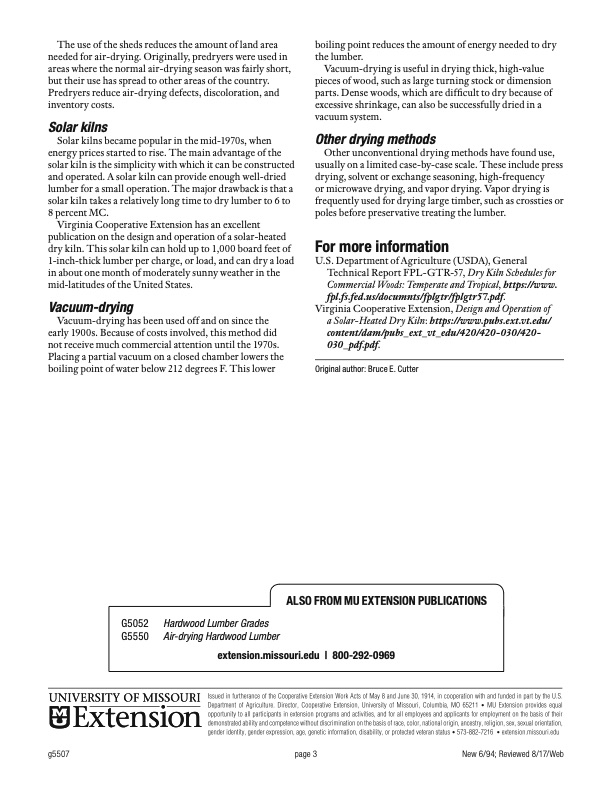
PDF Publication Title:
Text from PDF Page: 003
The use of the sheds reduces the amount of land area needed for air-drying. Originally, predryers were used in areas where the normal air-drying season was fairly short, but their use has spread to other areas of the country. Predryers reduce air-drying defects, discoloration, and inventory costs. Solar kilns Solar kilns became popular in the mid-1970s, when energy prices started to rise. The main advantage of the solar kiln is the simplicity with which it can be constructed and operated. A solar kiln can provide enough well-dried lumber for a small operation. The major drawback is that a solar kiln takes a relatively long time to dry lumber to 6 to 8 percent MC. Virginia Cooperative Extension has an excellent publication on the design and operation of a solar-heated dry kiln. This solar kiln can hold up to 1,000 board feet of 1-inch-thick lumber per charge, or load, and can dry a load in about one month of moderately sunny weather in the mid-latitudes of the United States. Vacuum-drying Vacuum-drying has been used off and on since the early 1900s. Because of costs involved, this method did not receive much commercial attention until the 1970s. Placing a partial vacuum on a closed chamber lowers the boiling point of water below 212 degrees F. This lower boiling point reduces the amount of energy needed to dry the lumber. Vacuum-drying is useful in drying thick, high-value pieces of wood, such as large turning stock or dimension parts. Dense woods, which are difficult to dry because of excessive shrinkage, can also be successfully dried in a vacuum system. Other drying methods Other unconventional drying methods have found use, usually on a limited case-by-case scale. These include press drying, solvent or exchange seasoning, high-frequency or microwave drying, and vapor drying. Vapor drying is frequently used for drying large timber, such as crossties or poles before preservative treating the lumber. For more information U.S. Department of Agriculture (USDA), General Technical Report FPL-GTR-57, Dry Kiln Schedules for Commercial Woods: Temperate and Tropical, https://www. fpl.fs.fed.us/documnts/fplgtr/fplgtr57.pdf. Virginia Cooperative Extension, Design and Operation of a Solar-Heated Dry Kiln: https://www.pubs.ext.vt.edu/ content/dam/pubs_ext_vt_edu/420/420-030/420- 030_pdf.pdf. Original author: Bruce E. Cutter ALSO FROM MU EXTENSION PUBLICATIONS G5052 Hardwood Lumber Grades G5550 Air-drying Hardwood Lumber extension.missouri.edu | 800-292-0969 g5507 page 3 New 6/94; Reviewed 8/17/WebPDF Image | Considerations in Drying Hardwood Lumber

PDF Search Title:
Considerations in Drying Hardwood LumberOriginal File Name Searched:
g05507.pdfDIY PDF Search: Google It | Yahoo | Bing
5,000 BF Shipping Container Lumber Dry Kiln For Quality Lumber The 5,000 BF container kiln consists of one 40 foot high-cube aluminum shipping container... More Info
Shipping Container Lumber Dry Kilns by Global Energy Global Energy designed and developed the container kiln back in 1991. The purpose is to give access to portable sawmill owners, furniture makers, and small business the value added profit of dry kiln lumber and quality hardwoods... More Info
Vacuum Kiln Conversion Kit for Lumber and Wood Dry Kilns Convert your existing conventional dry kiln into a fast drying vacuum kiln. Similar to vacuum bagging in the boat building and aircraft industry, we have come up with a proprietary process which allows you to build a very simple vacuum kiln at a fraction of the price, and without the intensive conventional metal chamber structure... More Info
Vacuum Pump Cart System for Bagging Clamping Wood Drying and more Vacuum Cart with 2HP Pump and Dual Pistons with multiple multiplex vacuum ports and liquid reservoir... More Info
Vacuum Bagging Basics Vacuum bagging is a method of clamping, which has traditionally been used in the composites industry, but can also be used for vacuum drying materials, including wood products... More Info
| CONTACT TEL: 608-238-6001 Email: greg@globalmicroturbine.com | RSS | AMP |